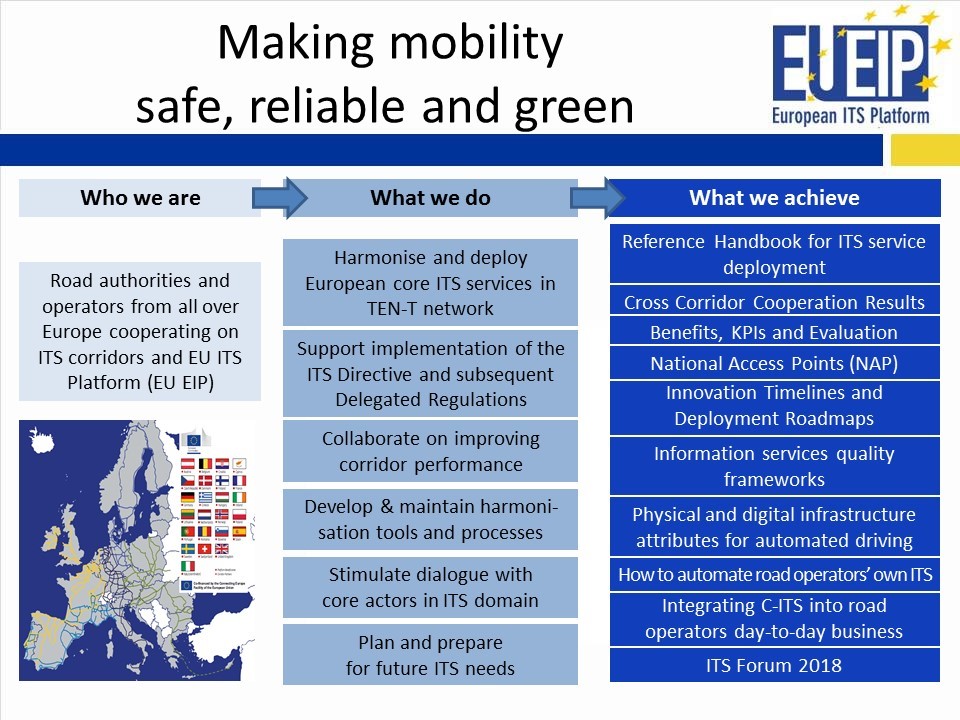DATEX II Recommended Profiles
The DATEX II standard supports the entire domain of road traffic and road travel data provision. As a result the DATEX II content standard offers the ablitity of a coherent dataprovision for a wide variety of services in relation to traffic and travel information and management, both on a network and individual basis. To support the different types of services using the DATEX II standard, the concept of Recommended Profiles is available. A profile is a subset of the entire standard, only containing the relevant data-elements required for a specific use case.
To ensure interoperability of information services profiles need to be implemented. Systems implementing the same DATEX II profile are interoperable by definition. To support the EU Delegated Regulations on ITS and the by EU-EIP maintained deployment guides, DATEX II developed and publishes reference profiles. The requirements for these profiles either come from the harmonisation and liaison processes run in the DATEX II organisation, the EU-EIP activity 4.5 or liaison with external stakeholder communities such as TISA and C-Roads.
The EU Delegated Regulations are supported by Recommended Reference Profiles (RRP's). These RRP's contain the minimum set of data-elements required to provide the information meant by the specific datacategory in the specific delegated regulation. With the DATEX II webtool it is possible to combine the RRP's to a set of RRP's covering the available information. Apart from that, it is possible to extent the RRP with information elements that are available in the specific source.
The EU-EIP reference handbook has described harmonised uses cases for the provision of data from the road operator's point of view. These use-cases are supported by so calles Recommended Service Profiles (RSP's). These RSP'sa are based on one or more RRP's and extended with data-elements described in the use case.
The Data For Road Safety has defined a RSP for the delivery of level 2 SRTI data, originating from vehicles, to the road operators.
In the future RSP's from other stakeholder domains will follow. (EV-Charging)
For more information about profiling, take a look at the Profiling Guide
Recommended Reference Profiles
RRP's give a harmonised interpretation of the data categories in the Delegated Regulations A, B, C and E of the EU ITS-Directive 2010/40.
This concerns the following Delegated Regulations:
- Delegated Regulation 886/2013 (SRTI, Action C)
- Delegated Regulation 962/2015 (RTTI, Action B)
- Delegated Regulation 1926/2017 (MTIS, action A)
It is of utmost importance, regarding the EC goal to provide harmonised data exchange, that the content (data categories) of the Data exchange initiated by the different regulations are modelled identical by the different operators. The supporting documentation set out very clearly which data elements are corresponding to the data categories and how they are to be recognised in the profile.
With the on-going maintenance of DATEX II, DATEX II takes care that profiles and their documentation are available when new versions of the relevant parts are published.
Recommended Service Profiles
EIP Recommended Service Profiles
The "EU ITS Platform" brings together the majority of the European key players, cooperating to establish an open "forum", aiming at providing valid contribution for the future strategy and policy recommendation for better development of ITS service along European Road Corridors.
To increase the efficiency of the TEN-T Core Network Corridors, it is mandatory to encourage the development of an integrated trans-European network and a better use of the existing infrastructures by employing intelligent transport systems as well as uniform technical standards. Interoperability must be discussed, designed, tested and finally deployed on the basis of the evolution of technology, standards, specifications and open interfaces. Ensuring continuity of high quality services for European end-users requires the creation of a proper environment for the harmonization of existing and future ITS Services.
For the key services of the roadoperators on this European roadnetwork the EU-IEP developed a best practise oriented Reference handbook for implementation of these services. This is laid down in the Reference Handbook for Service Deployment. An important aspect of the service harmonisation is the alignment of data-interfaces used in these services. As DATEX II developments were originally initiated by the motorway operators, the data-exchange standard for the service 2 service communication in the backbone is DATEX II. Based on the information requirements in the specific EU-EIP use cases, the relevant DATEX II RRP’s have been selected, combined where needed and completed with the non selected information elements to DATEX II profiles supporting the EIP services. These profiles are called: Recommended Service Profiles (RSP’s)
IDACS Recommended Service Profiles
In the course of the Programme Support Action (PSA) “Data collection related to recharging/refuelling points for alternative fuels and the unique identification codes related to e-Mobility actors” that was subsequently given the name IDACS, or “ID and Data Collection for Sustainable fuels in Europe”, the 15 member states of the consortium mandatorily have to collect data related to alternative fuels infrastructures, namely electric charging points and hydrogen refuelling stations (HRS) as part of activity 2. Other alternative fuels, such as CNG, LNG, LPG and highly-blended biofuels can be covered optionally.
As data collection mandatorily has to take place via the National Access Points (NAP) as defined in directive 2010/40/EU on the framework for the deployment of Intelligent Transport Systems in the field of road transport and for interfaces with other modes of transport, it is the aim of these profiles to give guidance on how this can be achieved.
The DATEX II Profiles made available for exchange of this information are the IDACS Recommended Service Profiles
Go back to the previous page
